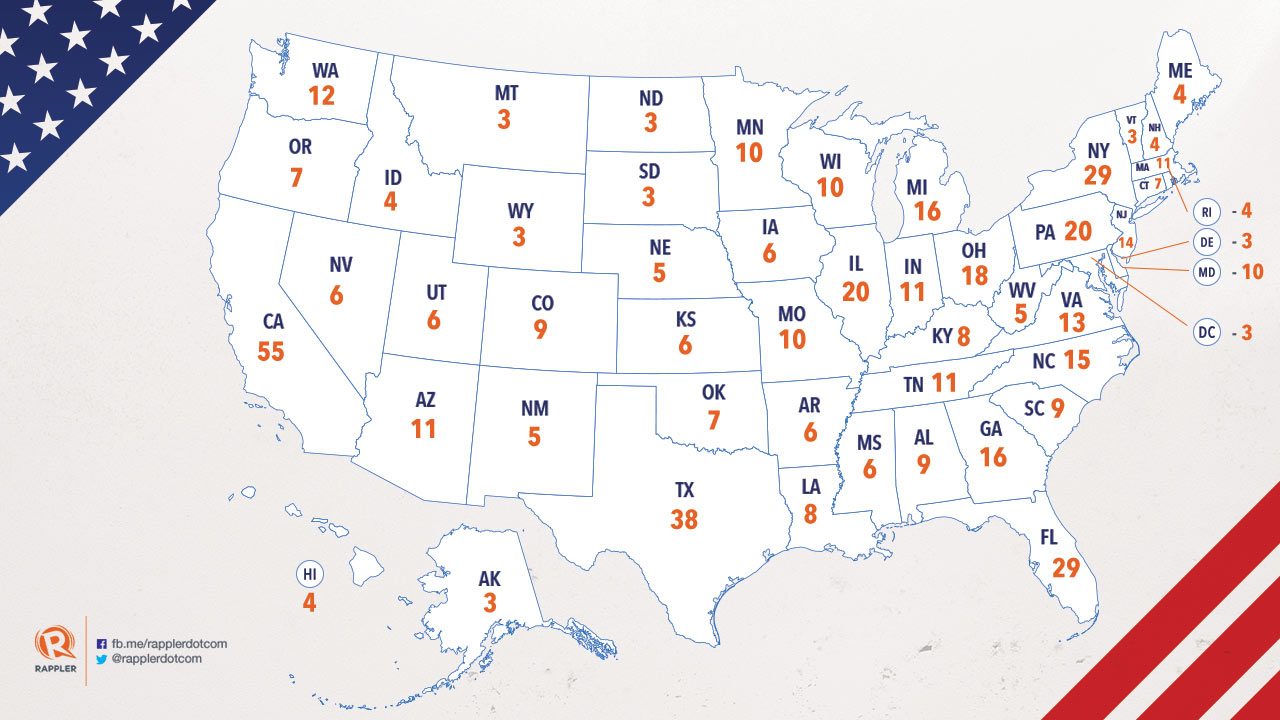SUMMARY
This is AI generated summarization, which may have errors. For context, always refer to the full article.

WASHINGTON DC, USA (UPDATED) – Winning a US presidential election takes years, billions of dollars and relentless determination. It also requires crunching a lot of numbers.
The victor must get to the magic number of 270 electoral college votes – but just trying to anticipate the result is a complicated exercise in adding, subtracting and combining.
That’s because the US election – taking place on November 8 – is not an exercise in direct democracy where a nationwide popular vote determines the result through a simple majority.
Candidates must instead win a majority of the electoral college votes assigned to the 50 states.
Those who win a state’s popular vote are apportioned the state’s electors, the number of which is roughly in line to the size of its population.
Except in Maine and Nebraska – which distribute electors through proportional systems – candidates earn electoral votes on a winner-take-all basis.
With a population of 38.8 million, California has 55 electoral votes, while Montana – population one million – has only three.
A total of 538 electoral votes are in play, corresponding to the total number of elected representatives in Congress (435 members of the House and 100 senators) plus 3 for the US capital Washington, DC.
Technically, it is those electors who elect the president and vice president in a formal rubber stamp vote on December 19.
Road to 270
To win the keys to the White House, candidates need a simple majority of electoral votes – 270.
And if history is any indicator, the path is far clearer for the Democratic candidate Hillary Clinton than for her Republican rival Donald Trump.
That’s because 18 states – providing a total of 242 electoral votes – have consistently voted for Democrats since 1992.

Another 13 states have picked Republicans over the same period, but they weigh in with only 102 votes.
Six more states appear to be firmly in Trump’s camp despite their votes shifting in the past.
The outcome in the remaining dozen “swing states” is more uncertain, and that’s where Clinton and Trump are focusing almost all their campaigning.
The more electors a state has, the more crucial its role, led by Florida with 29 electoral votes, Pennsylvania with 20 and Ohio with 18 – places the candidates continually visit.
Potentially, candidates could also forge a path to 270 by winning enough small states such as Nevada, Iowa and New Hampshire – or by winning a state that’s historically voted for the opposing camp.
The experts are taking all those factors into account as they explore multiple possible combinations – adding Ohio, subtracting Iowa, flipping a Democratic state here or a Republican one there.
Despite all the variations, many believe Florida – the mother of swing states – is the key to the election.
Without it, winning will be “very difficult” for Trump, his campaign manager Kellyanne Conway has admitted.
The swing states
Here’s a list of the major swing states, the number of electoral votes and the averages of recent polls through November 4 in a four-way race – including the outsiders, Libertarian Gary Johnson and Green candidate Jill Stein, and who won the state in the last two elections:
Florida: 29 electoral votes
Clinton has 47.4% support, Trump 46.2%
2008 and 2012: Barack Obama (D)
Pennsylvania: 20 electoral votes
Clinton at 46.8%, Trump at 43.8%
2008 and 2012: Obama (D)
Ohio: 18 electoral votes
Trump at 46.3%, Clinton at 43%
2008 and 2012: Obama (D)
Georgia: 16 electoral votes
Trump at 48.3%, Clinton at 42.7%
2008: John McCain (R)
2012: Mitt Romney (R)
Michigan: 16 electoral votes
Clinton at 46%, Trump at 40.3%
2008 and 2012: Obama (D)
North Carolina: 15 electoral votes
Trump at 46.8%, Clinton at 46%
2008: Obama (D)
2012: Romney (R)
Virginia: 13 electoral votes
Clinton at 46.6%, Trump at 41.4%
2008 and 2012: Obama (D)
Arizona: 11 electoral votes
Trump at 46.3%, Clinton at 42.3%
2008: McCain (R)
2012: Romney (R)
Colorado: 9 electoral votes
Clinton at 42.8%, Trump at 40.2%
2008 and 2012: Obama (D)
Iowa: 6 electoral votes
Trump at 41.7%, Clinton at 40.3%
2008 and 2012: Obama (D)
Nevada: 6 electoral votes
Trump at 46%, Clinton at 44%
2008 and 2012: Obama (D)
New Hampshire: 4 electoral votes
Trump at 43.5%, Clinton at 42%
2008 and 2012: Obama (D)
Utah is also proving interesting despite having voted Republican since 1968. Forty-year-old independent Evan McMullin, a Mormon and former CIA officer who entered the race in August, is running close on Trump’s heels. – Rappler.com
Add a comment
How does this make you feel?





There are no comments yet. Add your comment to start the conversation.